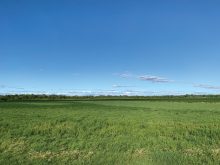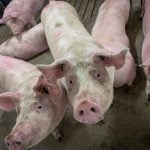Perennial grass buffer strips in New Mexico fields have been shown to conserve water and block wind, and they may be useful to Manitoba organic farmers.
Sangamesh (Sangu) Angadi, a professor of crop stress physiology at New Mexico State University, presented some of his research on growing in water-limited conditions to members of the Manitoba Organic Alliance on November 2.
Where Angadi works, agriculture relies on irrigation. Water comes from the Ogallala aquifer, also known as the High Plains aquifer which stretches from South Dakota to Texas and is one of the largest in the U.S.
Read Also

Manitoba farmers uneasy on expropriation
Farmland expropriation for Oak Bluff highway project brings process, farmer compensation concerns back to the fore.
Extensive development around the aquifer has caused water levels to drop. In 2017 the average drop was about 15 feet, an article from Oklahoma State University said. This varies from spot to spot.
Angadi said his site at Clovis, New Mexico, can expect water to deplete faster because it’s at the tip of the aquifer.
At its current rate of decline, the southern states along the aquifer will have to return 35 per cent of agricultural land back into dry land within two decades, Angadi said.
He’s working on finding ways to reduce agricultural water use.
Meanwhile, “any plant stress that you can think of exists here,” Angadi said — high and low temperatures, high winds, sandblasting, and drought.
“That made my job interesting,” he said.
One of Angadi’s studies involved planting concentric rings of native perennial grasses in the fields — which are circular due to centre-pivot irrigation.
Angadi said farmers don’t farm the entire circle at any given time due to lack of water so planting grasses doesn’t waste space.
The grasses address several issues. High winds, for instance, are a problem but shelterbelts require too much water and couldn’t shield a whole field. Strips of grass in concentric circles showed they could slow wind speeds across the field.
They also cycled water more efficiently. Angadi explained soils are very level and have poor organic matter. After intense rainfall — how the area gets about half of its rain — most of the water leaves the soil. The buffers proved effective at soaking up water and holding it in the soil.
Comparing results with conventional fields showed the “clear benefit of a circular buffer strip,” said Angadi.
Next to the grass on the outer edge of the ring, the crop saw a nine per cent yield benefit. At the centre of the (cropped) ring, the crop saw a 20 per cent benefit, and at the inner edge of the ring it saw a 15 per cent benefit. Over three years, results were very similar.
The strips also added biodiversity benefits and bird habitat.
For Manitoba farmers, buffer strips are “another tool in the tool box,” Martin Entz told the Co-operator.
Entz is a professor of cropping systems and natural systems agriculture at the University of Manitoba. He hosted the webinar.
“Before glyphosate-based no till, vegetative buffers were tested in places like Swift Current to see how they could help with water use efficiency — by trapping snow and reducing water evaporation from soil,” he said. “This application is of interest to Manitoba organic farmers today.”
A study in the late 1980s and early 1990s used four-foot-tall wheatgrass rows, spaced 50 feet apart as windbreaks for non-irrigated alfalfa fields. Over-winter recharge of the soil averaged one inch greater than in the open field and led to an average nearly one-third increase in hay yield.
A 1990 study using tall wheatgrass strips in a wheat cropping system found it increased spring soil water reserves by an average of 23 mm or just under one inch. Over six years, spring wheat yields averaged 15 per cent higher yields between the strips than in open fields.
“Today with perennial wheat (Kernza) on the horizon, there are new possibilities to harvesting some grain from the perennial strips,” Entz added. “Exciting stuff.”


















